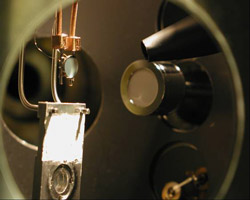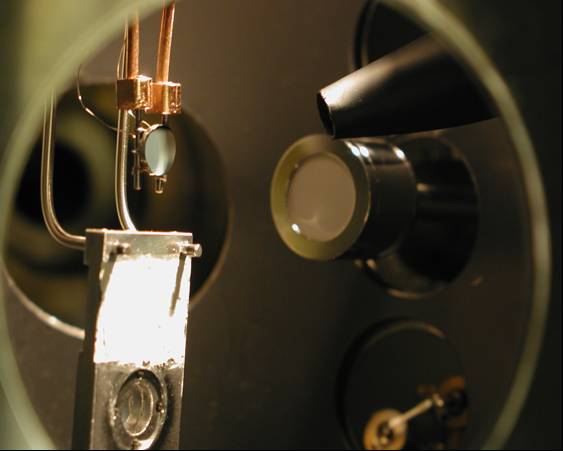Photons Team Up
Ultraviolet light can eject electrons from a solid surface, a phenomenon known as the photoelectric effect. Albert Einstein got his only Nobel Prize for explaining it a century ago. Now, in the 15 September PRL, researchers report that intense infrared light can work with the ultraviolet to boost or retard the emitted electrons. This “laser-assisted photoelectric effect,” previously seen only in clouds of atoms, could allow them to track the intricate dance of electrons in solids over times much shorter than a femtosecond, 10-15 seconds.
Researchers first saw the laser-assisted photoelectric effect (LAPE) a decade ago by simultaneously hitting a cloud of atoms with both ultraviolet (UV) and infrared pulses [1]. With just a UV pulse, the ejected electrons formed narrow peaks in the energy spectrum, with each peak corresponding to an energy level in the atoms. But with a synchronized infrared pulse present, each electron could pick up or lose the energy of an infrared photon as it emerged from its atom. These new possibilities generate two small “sideband” peaks to the right and left of each main peak in the spectrum of emitted electrons–one peak with slightly more energy and one with slightly less energy than the UV-only peak.
The atomic experiment has been useful for probing both the pulses and the rapid behavior of electrons in atoms, but “it was not understood that the same effect could happen at a surface,” says Margaret Murnane of JILA and the University of Colorado in Boulder, who leads a research team with Henry Kapteyn. And it turns out that the experiment with solids could potentially reveal complex electron reshuffling in materials at time-scales measured in attoseconds (10-18 seconds), says Murnane. But electrons inside a solid usually have a wide range of energies–rather than the simple, discrete levels found in atoms–which makes the sidebands in the spectrum hard to detect.
So Murnane and her colleagues used a carefully prepared platinum surface, which contains a so-called d-band–a group of electron energy states with a narrow energy range, as in an atom. The team hit their sample with 35-femtosecond-long infrared pulses and 10-femtosecond-long UV pulses, which generated the LAPE signature sidebands when the pulses overlapped in time. By shifting the relative timing of the pulses, they hope ultimately to create “movies” showing how electrons in the solid reorganize in response to excitation. For example, they could watch the sidebands change from one femtosecond to the next.
Murnane and her colleagues managed to fit the data with the same simple theory used for the atomic experiments, despite the many complexities of solids. Ernie Glover of Lawrence Berkeley National Laboratory in California, who first demonstrated the effect for atomic vapors, says that the success of the simple model is a pleasant surprise. “The finding that the major features can be described simply,” he says, “opens the door for probing electron dynamics in solids with attosecond resolution.”
–Don Monroe
Don Monroe is a freelance science writer in Murray Hill, New Jersey.
References
- T. E. Glover, R. W. Schoenlein, A. H. Chin, and C. V. Shank, “Observation of Laser Assisted Photoelectric Effect and Femtosecond High Order Harmonic Radiation,” Phys. Rev. Lett. 76, 2468 (1996)
More Information
Description of the technique for creating synchronized infrared and UV or x-ray pulses: Physics Today article from 2005 (requires subscription)





